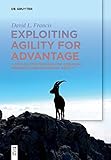Exploiting Agility for Advantage : A Step-by-Step Process for Acquiring Requisite Organisational Agility / David L. Francis.
Material type: TextPublisher: Berlin ; Boston : De Gruyter, [2020]Copyright date: ©2020Description: 1 online resource (XIII, 291 p.)Content type:
TextPublisher: Berlin ; Boston : De Gruyter, [2020]Copyright date: ©2020Description: 1 online resource (XIII, 291 p.)Content type: - 9783110636451
- 9783110637458
- 9783110637267
- online - DeGruyter
| Item type | Current library | Call number | URL | Status | Notes | Barcode | |
|---|---|---|---|---|---|---|---|
 eBook
eBook
|
Biblioteca "Angelicum" Pont. Univ. S.Tommaso d'Aquino Nuvola online | online - DeGruyter (Browse shelf(Opens below)) | Online access | Not for loan (Accesso limitato) | Accesso per gli utenti autorizzati / Access for authorized users | (dgr)9783110637267 |
Frontmatter -- Preface -- Contents -- Key Abbreviations Used -- Part I: Requisite Agility -- 1 Exploiting Agility for Advantage -- 2 What is Organisational Agility? -- 3 Prudent Opportunism -- 4 Leading Agile Enterprises -- Bibliography for Part I -- Part II: The EAfA Process -- 5 Introduction to Part II: Using the EAfA Process to Exploit Agility for Advantage -- 6 Step One – Orientating: What is known about achieving requisite agility? -- 7 Step Two – Predicting: How might we need to change in the future? -- 8 Step Three – Diagnosing: Do we have the capabilities to be agile? -- 9 Step Four – Envisioning: What will we be like when we are requisitely agile? -- 10 Step Five – Scoping: Where, when and how, do we need to be agile? -- 11 Step Six – Customising: What types of agility do we need? -- 12 Step Seven – Delivering: How can we make progress? -- Bibliography for Part II -- Part III: Resources -- 13 Theory, References and Follow-Up Reading -- Index
restricted access online access with authorization star
http://purl.org/coar/access_right/c_16ec
Many argue that all organisations should strive to be agile. Exploiting Agility for Advantage takes a radically different view. The author’s research shows that requisite agility is required, meaning ‘not too much, not too little, of the right type and delivering wanted agility deliverables’. This is a book for managers who want their enterprise to be intelligently agile but don’t know how to achieve this. Part One shows why agility is a strategic option for commercial and not-for-profit enterprises. Part Two describes, in detail, a seven-step agility-orientated development programme for work-groups or entire organisations. Part Three provides academic underpinning on organisational agility for researchers and students of management. "Agility isn’t easy and developing it is going to need much more than a simple slogan. This book offers very helpful insights into the detailed mechanisms that underpin this capability, and practical guidance around how to build and embed them." (Prof. John Bessant) Author videos: https://vimeo.com/449735611 https://vimeo.com/461491774
Mode of access: Internet via World Wide Web.
In English.
Description based on online resource; title from PDF title page (publisher's Web site, viewed 30. Aug 2021)


